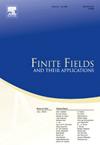特征二上Fq3上排列五反常的进一步结果
IF 1.2
3区 数学
Q1 MATHEMATICS
引用次数: 0
摘要
让q = 2 m。在最近的一篇论文[34]中,Zhang和Zheng研究了几种形式为ϵ0xd0+L(ϵ1xd1+ϵ2xd2) / Fq3(d0=1,2,4)的具有一定线性化多项式L(x)的置换五反常。他们运用多元方法和特定技术分析了某些方程的解的个数,并提出了一个开放性问题:一些这种形式的五反常项的置换性质尚未得到证明。在本文中,受[12]思想的启发,我们进一步刻画了Fq3(d0=1,2,4)上这类五反常的置换性质。本文提出的技术将有助于研究更多新的置换多项式类。本文章由计算机程序翻译,如有差异,请以英文原文为准。
Further results on permutation pentanomials over Fq3 in characteristic two
Let . In a recent paper [34], Zhang and Zheng investigated several classes of permutation pentanomials of the form over with a certain linearized polynomial . They applied the multivariate method and specific techniques to analyze the number of solutions of certain equations, and proposed an open problem: the permutation property of some pentanomials of this form remains unproven. In this paper, inspired by the idea of [12], we further characterize the permutation property of such pentanomials over . The techniques presented in this paper will be useful for investigating more new classes of permutation polynomials.
求助全文
通过发布文献求助,成功后即可免费获取论文全文。
去求助
来源期刊
CiteScore
2.00
自引率
20.00%
发文量
133
审稿时长
6-12 weeks
期刊介绍:
Finite Fields and Their Applications is a peer-reviewed technical journal publishing papers in finite field theory as well as in applications of finite fields. As a result of applications in a wide variety of areas, finite fields are increasingly important in several areas of mathematics, including linear and abstract algebra, number theory and algebraic geometry, as well as in computer science, statistics, information theory, and engineering.
For cohesion, and because so many applications rely on various theoretical properties of finite fields, it is essential that there be a core of high-quality papers on theoretical aspects. In addition, since much of the vitality of the area comes from computational problems, the journal publishes papers on computational aspects of finite fields as well as on algorithms and complexity of finite field-related methods.
The journal also publishes papers in various applications including, but not limited to, algebraic coding theory, cryptology, combinatorial design theory, pseudorandom number generation, and linear recurring sequences. There are other areas of application to be included, but the important point is that finite fields play a nontrivial role in the theory, application, or algorithm.

 求助内容:
求助内容: 应助结果提醒方式:
应助结果提醒方式:


